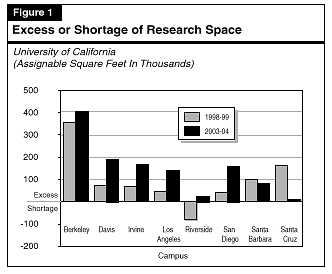Legislative Analyst's Office
Analysis of the 2000-01 Budget Bill
Crosscutting Issues
Capital Outlay
Action Steps for
Funding Higher Education Capital Outlay
We recommend the Legislature evaluate capital outlay proposals by the three segments as a statewide system rather
than independent segments and apply statewide guidelines when making funding decisions. This will allow the state to
use limited resources to maximum effect.
With limited resources, the state should invest in higher education capital outlay projects that will result in maximum
educational benefit statewide. This can be done by considering all capital outlay proposals across higher education rather
than for each segment in isolation of the others and evaluating capital needs using statewide guidelines. This will allow the
highest priority projects to be funded and permit the state to provide a high quality educational opportunity to all qualified
students.
To have such a legislative review and approval process, we recommend the Legislature take the following actions:
- Appropriate Funds on the Basis of Statewide Priorities and Criteria, Not the "One-Third" Formula Used in Recent
Years. In recent years the California Community Colleges (CCC), California State University (CSU), and University of
California (UC) agreed with the administration to allocate approximately equal amounts of voter-approved bond funds
to each segment in the budget. Using an arbitrary formula like this does not take into account different needs of the
segments and campuses. We recommend the Legislature appropriate funds based on statewide priorities and criteria
rather than the "one-third" formula used in the past.
- Evaluate Projects From All Three Segments as a Common Pool. When capital outlay proposals are evaluated
segment-by-segment, a lower-priority project in one segment may be funded while higher-priority projects in other
segments may not be funded. To avoid this, we recommend the Legislature evaluate capital outlay proposals from all
three segments out of a common pool using statewide priorities and criteria.
- Focus Resources on Undergraduate Instructional Needs. Department of Finance estimates show undergraduate
enrollment at the three segments will grow by about 280,000 full-time equivalent (FTE) students between now and 2008,
about a 20 percent increase. To accommodate this increase at all campuses, we recommend the Legislature focus on
funding undergraduate instructional needs. In order to avoid overbuilding at individual campuses and capitalize on
distance learning and other instructional technologies, we recommend the Legislature not fund new instructional space if
to do so will increase a campus's instructional capacity above 95 percent of that justified in the year of the project's
scheduled completion.
- Recognize Existing Investment in Research Facilities. The UC has 2 million assignable square feet (asf) of
instructional space and 8.4 million asf of research space. Figure 1 shows the shortage or excess of research space at the
general campuses in 1998-99 and estimated in 2003-04, using historic space guidelines. It shows, for instance, that all
campuses had excess space in 1998-99 and all but the Riverside campus are projected to have excesses in 2003-04. In
order to allow limited state resources to be focused on undergraduate instructional needs and avoid overbuilding
research space, we recommend the Legislature not fund new research space if to do so would increase a campus's
research space above 90 percent of that justified in the year of the project's scheduled completion. If UC wants more
research space, it can use other funding mechanismssuch as "Garamendi" bonds and overhead revenue from research
grants and contracts.
- Use of Campus Facilities Year-Round. Last year, we recommended that projects be funded based on year-round
operation of campus facilities (see our report Year-Round Operation in Higher Education, February 1999). We continue
to believe the campuses should operate fully on a year-round basis. In the Supplemental Report of the 1999-00 Budget
Act, the Legislature directed CSU and UC to each submit a report to the Legislature by April 1, 2000 on the feasibility of
implementing year-round operation. The Governor has directed the Department of Finance to prepare a similar report.
Capital outlay planning and funding should reflect the Legislature's actions on year-round operation throughout higher
education.

Beginning in 2001-02, the segments should develop capital outlay proposals that reflect these actions so that the Legislature
can assess higher education needs as a statewide system.
Return to Capital Outlay Table of Contents, 2000-01 Budget Analysis
Return to 2000-01 Budget Analysis Table of Contents
Return to LAO Home Page

